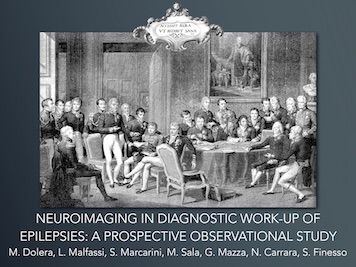NEUROIMAGING IN DIAGNOSTIC WORKUP OF CANINE EPILEPSIES: A PROSPECTIVE OBSERVATIONAL STUDY
Introduction
Canine epilepsy includes a group of heterogeneous pathologies that share the chronic recurrence of seizures. Historically epilepsy has been divided in symptomatic, reactive and idiopathic epilepsy. Several papers classified retrospectively canine epilepsies, taking in consideration the clinical presentation, the age of onset, laboratory works and postmortem findings. Some literature on veterinary was focused on the diagnostic workup of epilepsy and none stated neuroimaging role. The aim of this work was to examine the evidence-based and imaging-guided prevalence of canine epilepsies. Based on MRI findings a new evidence-based and imaging-guided classification is proposed.
Methods
A prospective observational single institution study was conducted on 201 dogs which had been referred for recurrent seizures. Clinical examinations, blood cell counts, complete biochemical profiles and urine analyses were performed. All the patients underwent a total body high field of 1.5T MRI (MRI Intera 1.5T, Philips Medical Systems, Eindhoven, the Netherlands). The further laboratory tests had been carried out if specific infectious diseases were suspected. On the basis of MRI findings and previous classifications, epilepsies had been divided in three groups: functional, structural and metabolic. Functional epilepsy was identified when no latent structural brain lesions were detected by MRI and no metabolic disorders were identified by laboratory work. If abnormal MRI findings which were not referable to any pre-existing brain diseases were detected, they had been assigned to a sub-group of functional epilepsy with MRI postictal discoveries. Structural epilepsy was indicated when the brain abnormalities were detected by MRI. Metabolic epilepsy was indicated when metabolic disorders with compatible MRI findings were detected.
Results
Out of the 201 dogs considered 62% of them were affected by structural epilepsies, 24% by functional and 14% metabolic. Among symptomatic patients the clinico-pathological categorization was: 35% neoplastic, 32.2% inflammatory, 14% malformative, 12.6% vascular, 4.8% traumatic, 2% degenerative. Among our population 36.6% of patients with functional epilepsy showed postictal changes (focal T2-w gray matter hyperintensity and/or thinning of the temporal cortex) on MRI examination.
Conclusion
The systematic use of high field MRI in canine epilepsy diagnostic workup makes a substantial contribution to the classification of canine epilepsies. Findings from imaging together with complete clinical and laboratory exams provide syndromic and etiological diagnoses and lead to effective therapeutic strategies and prognosis. This is the first study conducted by the systematic use of MRI in canine epilepsies. A high field MRI proved to be the gold standard imaging technique. Further studies will be required to validate the neuroimaging-guided classification of canine epilepsies.
